When it comes to bicycle tire valves, there are different types to consider. Understanding these valve types is essential for maintaining and repairing your bike. In this article, I will discuss the various types of valves commonly found on bicycles, including Schrader valves, Presta valves, and Dunlop valves.
Schrader valves are wider and often found on inexpensive bike models. They have a spring-loaded check valve that controls airflow. On the other hand, Presta valves are narrower and commonly used on higher-end bicycle tires. Presta valves have a threaded stem that screws into the rim, creating an airtight seal. In Europe and Asia, the Dunlop valve is commonly used on city bikes.
Each type of valve has its advantages and is suited for different biking needs. In the next sections, we will explore the specifics of each valve type, their benefits, and considerations when choosing the right valve for your bike.
Key Takeaways:
- Schrader valves are wider and commonly found on inexpensive bike models.
- Presta valves are narrower and used on higher-end bicycle tires.
- Dunlop valves are commonly used in Europe and Asia, especially on city bikes.
- Understanding the different valve types is important for maintaining and repairing your bike.
- Consider the advantages of each valve type and choose the one that best suits your biking needs.
Types of Bike Tire Valves
When it comes to bike tire valves, there are three main types: Schrader valves, Presta valves, and Dunlop valves. Each valve type has its own unique features and applications. Let’s take a closer look at each one:
Schrader Valve
The Schrader valve, also known as the American valve, is commonly found on car tires and lower-end bicycle models. It features a wider diameter and a spring-loaded check valve that controls the airflow. Schrader valves are easy to use and can be inflated using a standard car tire pump.
Presta Valve
The Presta valve, also known as the French valve, is narrower and commonly found on higher-end bicycles and road bikes. It requires a smaller hole in the rim, making the rim stronger. Presta valves have a threaded stem that screws into the rim, creating an airtight seal. This valve type is lighter and can hold higher air pressures, making it ideal for high-performance bikes.
Dunlop Valve
The Dunlop valve, also known as the Dutch valve, is wider and often used on city bikes. It is commonly found in Europe and Asia. The Dunlop valve is similar to the Schrader valve but with a different internal design.
Here’s a visual representation of the different types of bike tire valves:
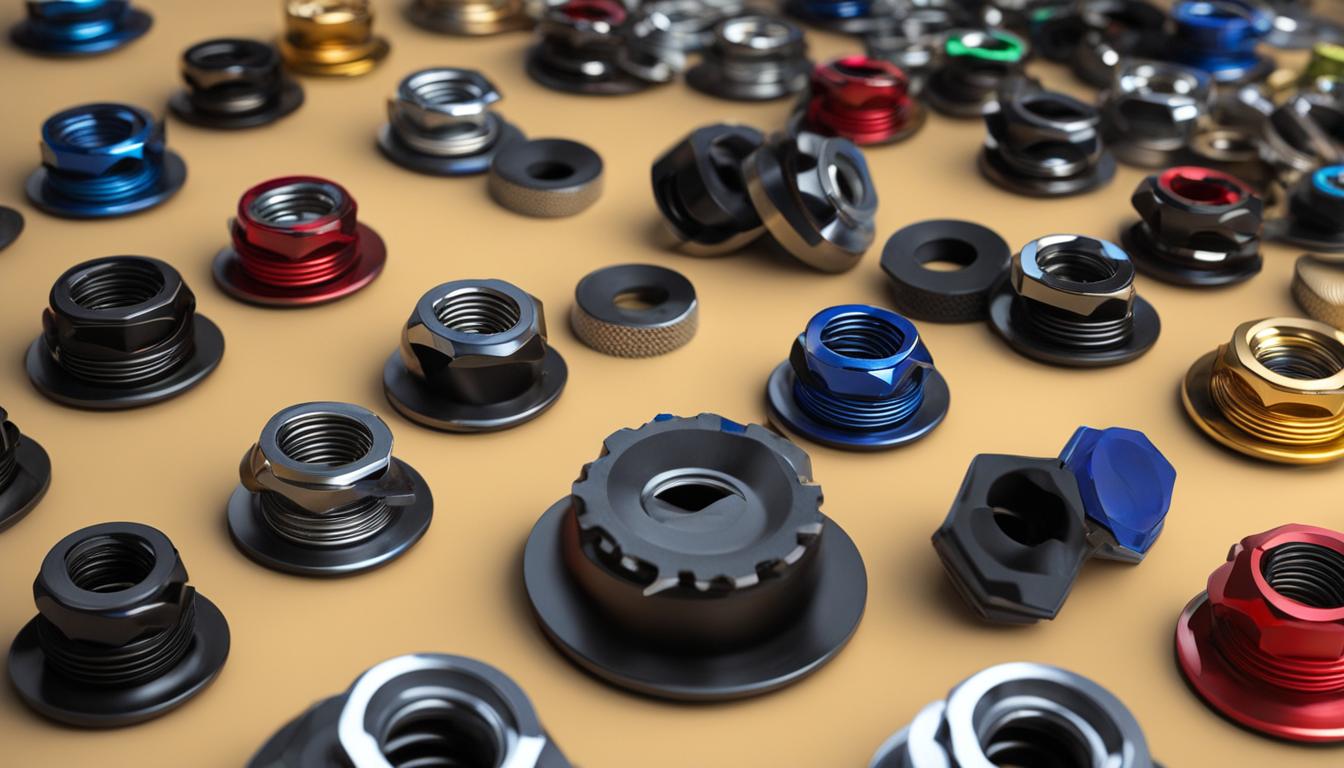
| Valve Type | Widest Diameter | Application |
|---|---|---|
| Schrader Valve | 8.5mm | Common on car tires and lower-end bicycles |
| Presta Valve | 6mm | Common on higher-end bicycles and road bikes |
| Dunlop Valve | 8mm | Common on city bikes |
Understanding the different types of bike tire valves is important for selecting the right valve type for your bike and ensuring proper inflation. Choose the valve type that aligns with your bike’s specifications and your riding needs.
Why Do Bikes Use Presta Valves?
Presta valves are a popular choice for road bikes and high-performance bicycles, offering several advantages over Schrader valves. These valves are designed to fit smaller holes in the rim, which helps strengthen the rim structure. Additionally, Presta valves are lighter in weight and can withstand higher air pressures, making them suitable for fast and competitive riding.
Unlike Schrader valves, Presta valves do not have a check valve. Instead, they rely on air pressure to create a seal. This feature contributes to their ability to hold higher pressures and allows for more precise control over tire inflation. Furthermore, Presta valves are equipped with a threaded stem that can be tightened to ensure an airtight seal, preventing air leakage during rides.
The use of Presta valves in road bikes and high-performance bicycles demonstrates their compatibility with the demands of these specific types of riding. Their smaller size and reliance on pressure sealing make them an ideal choice for racers and enthusiasts who prioritize lightweight components and high performance.
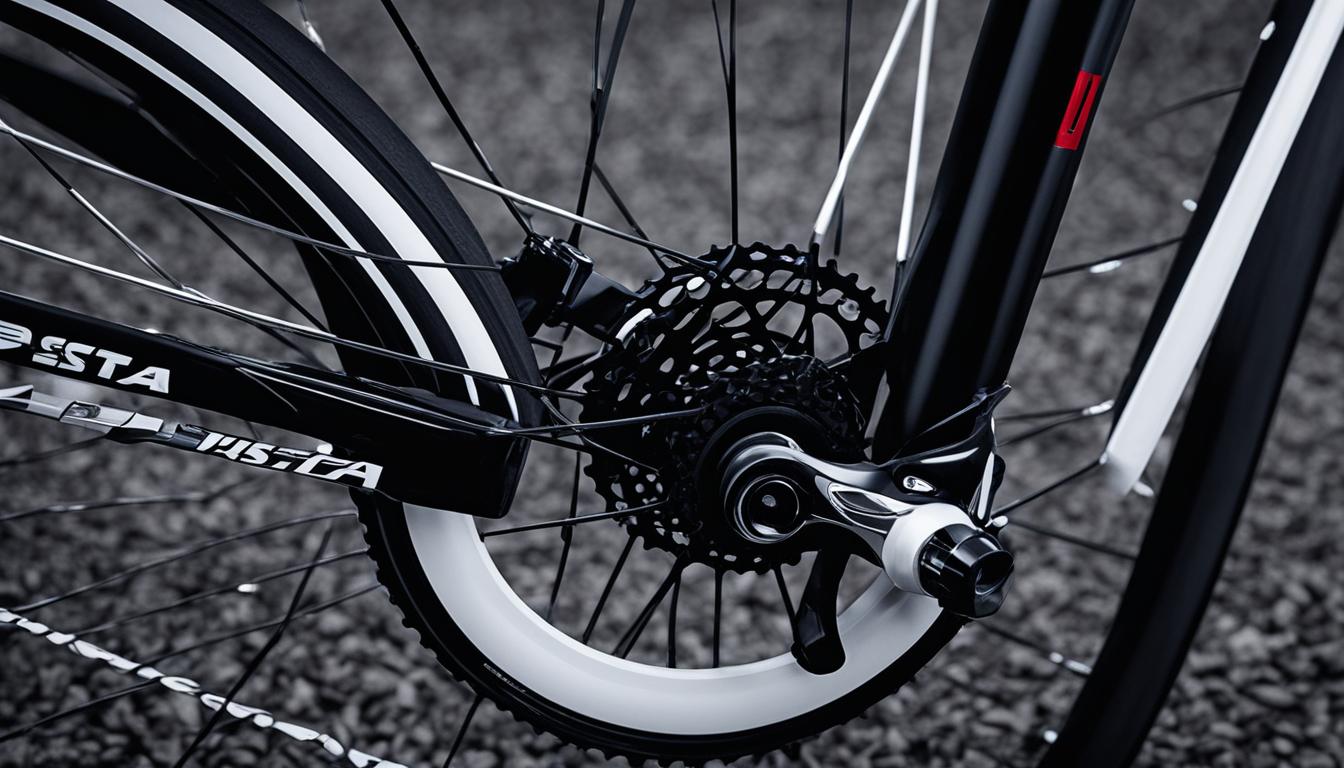
Can You Mismatch Presta and Schrader?
When it comes to using a Presta tube on a Schrader rim or a Schrader tube on a Presta rim, it is possible, but not recommended in most cases. While it may be tempting to improvise in emergencies, it is essential to consider the potential risks and drawbacks.
Using a Presta-specific tube on a rim drilled for Schrader valves can be a short-term fix, but it may not provide a reliable long-term solution. The main concern is the size mismatch between the valve hole and the valve itself. The wider Schrader hole can cause the narrower Presta valve to move around, potentially leading to damage and even puncturing the tube.
On the other hand, widening the valve hole on a Presta-drilled rim to fit a Schrader tube is not advisable. Altering the rim’s original design can compromise its integrity, affecting the overall safety and performance of the bike.
It is always best to use the appropriate tube and valve combination for your specific rim and bicycle model. While there may be instances where a mismatched valve can be temporarily used in emergency situations, it is crucial to replace it with the correct valve as soon as possible.
Considerations for Emergency Fixes
In situations where using a Presta tube on a Schrader rim or a Schrader tube on a Presta rim is the only available option, here are a few tips to minimize the risks:
- Ensure the tube’s valve stem is secure and centered within the larger valve hole.
- Take care when inflating the tire to avoid putting excessive pressure on the valve.
- Monitor the valve and tube closely for any signs of movement or damage during rides.
- Replace the mismatched tube and valve as soon as possible to maintain optimal performance and safety.
Remember, these emergency fixes should only serve as temporary solutions. It is crucial to equip your bike with the appropriate tubes and valves to ensure long-term reliability and performance.
| Possible Risks of Mismatched Valves | Recommended Solution |
|---|---|
| The Presta valve may move around and potentially cut the tube due to the larger Schrader hole. | Use the correct tube and valve combination for your rim. |
| Widening the valve hole on a Presta-drilled rim can compromise the rim’s integrity. | Avoid altering the rim’s original design and choose the appropriate valve for your rim. |
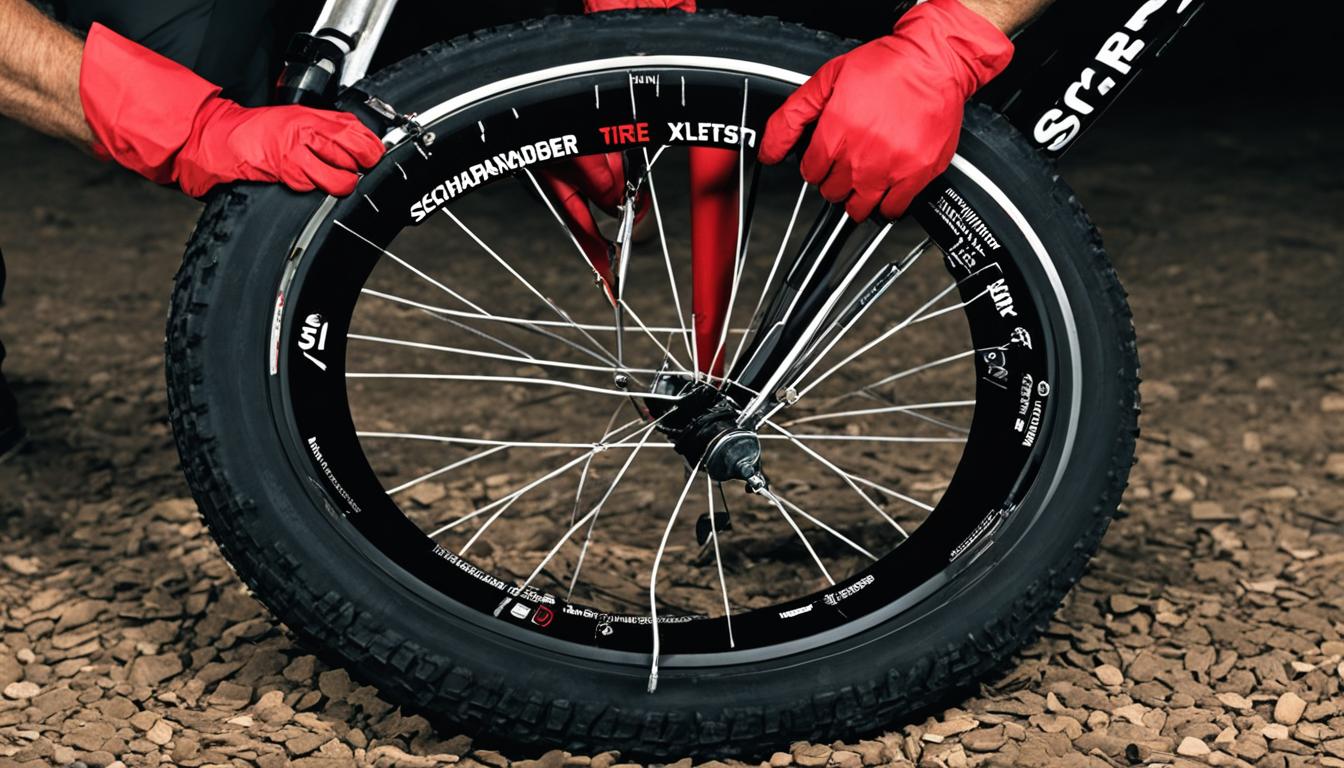
Valve Lengths
When it comes to installing tubes or purchasing new ones for your bicycle tires, using the appropriate valve length is crucial to ensure a proper fit with the depth of your rims. Different rims require different valve lengths to accommodate their specific designs. Here’s what you need to know about valve lengths for bicycle tires.
Standard Valve Lengths for Most Rims
Most Presta tubes come with valve lengths ranging from 40 to 48mm, which are suitable for standard rims. These valve lengths work well for most bikes and provide a secure seal for optimal inflation and performance.
Valve Lengths for Deep-Section Rims
However, if you have deeper-section aero wheels or rims, you may need longer valve lengths to ensure proper functionality. Deep-section rims are typically found on high-performance bikes or those designed for aerodynamics.
For deep-section rims, valve lengths of 80mm or even 100mm may be necessary to reach the valve opening and allow for easy inflation. Using shorter valves on these rims can make it difficult to access the valve and may result in air leakage during inflation.
If you have a tube with a shorter valve and deep-section rims, don’t worry! Valve extenders are available to help accommodate shorter lengths, allowing you to safely use your existing tubes without having to purchase longer ones.
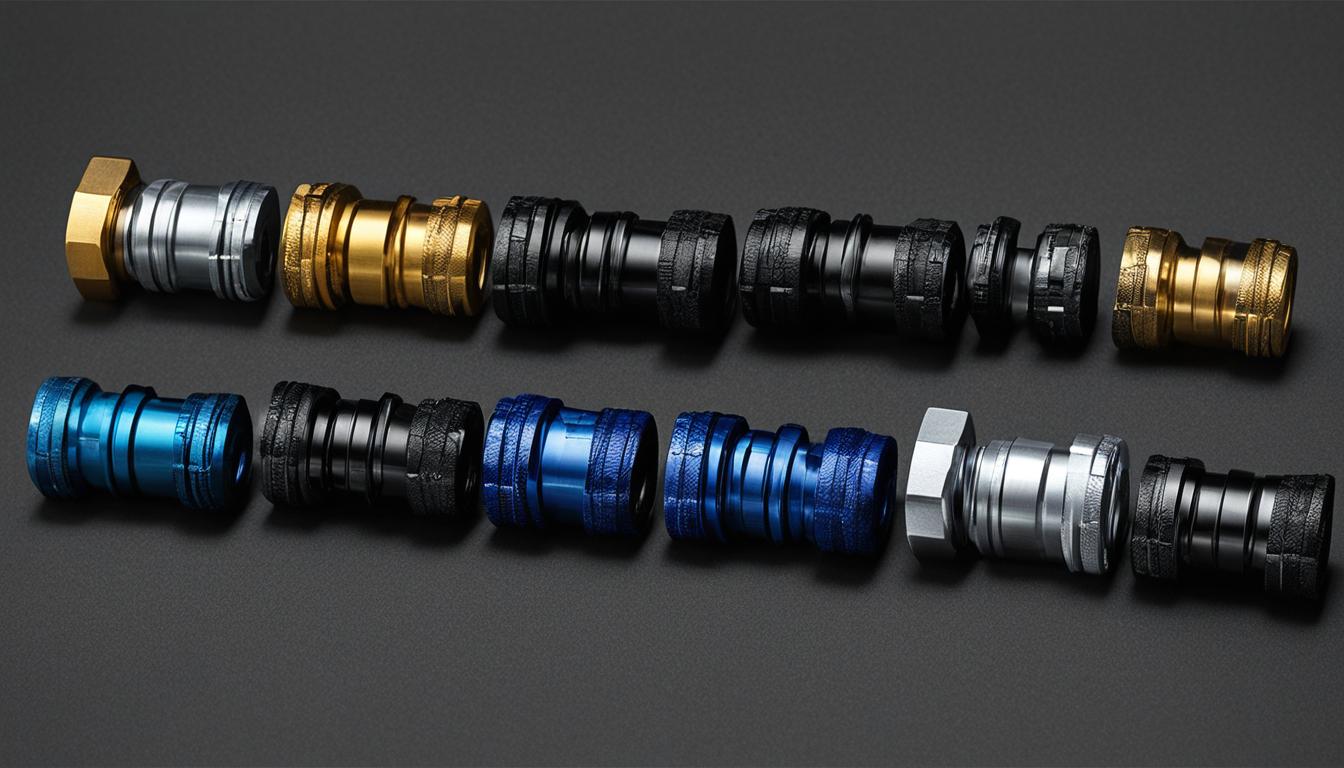
The image above provides a visual representation of valve lengths and how they correspond to different rim depths. As you can see, a longer valve is needed to penetrate the rim and provide a secure connection for inflation.
When choosing valve lengths for your bicycle tires, always consider the depth of your rims. It’s crucial to ensure a proper fit to prevent any issues during inflation or riding.
By using the correct valve lengths, you can maintain the integrity of your rims, prevent air leaks, and ensure a smooth and efficient cycling experience.
Which Pump Should I Use with These Valves?
When it comes to inflating your bike tires, using the right pump is essential for a smooth and efficient process. Different types of pumps are designed to work with specific valve types, ensuring a secure and airtight connection. Let’s take a look at the pumps suitable for the most common bike tire valves: Schrader, Presta, and Dunlop.
Schrader Valve Pump
If your bike is equipped with Schrader valves, you’ll need a pump specifically designed for this valve type. Schrader-only pumps are readily available and can be easily identified by their wider nozzles. These pumps are commonly used for cars and bicycles with Schrader valves, making them a versatile choice for both purposes. With a Schrader valve pump, you can effortlessly inflate your tires and get back on the road in no time.
Presta Valve Pump
For bikes with Presta valves, a Presta-only pump is the ideal tool for inflation. Presta valves are narrower and require a different nozzle design to create an airtight seal. Presta-only pumps are specifically engineered with a narrower nozzle and threaded connection to fit Presta valves snugly. These pumps are often preferred by cyclists who ride high-performance bikes or road bikes equipped with Presta valves.
Dual-Head Pumps
If you own multiple bikes with different valve types or prefer the convenience of a versatile pump, a dual-head pump may be the perfect solution. Dual-head pumps feature interchangeable nozzles that can accommodate both Schrader and Presta valves. With a quick switch of the nozzle, you can seamlessly switch between valve types without the need for adapters or additional equipment. Dual-head pumps offer flexibility and convenience, ensuring compatibility with various bike tire valves.
Adaptors for Presta Valves
Suppose you already have a Schrader-only pump but need to inflate a tire with Presta valves. In that case, you can purchase a separate adaptor to use with your existing pump. These adaptors act as a transitional piece, allowing you to connect your Schrader pump to Presta valves securely. With an adaptor, you can save money on buying a separate pump while still enjoying the versatility to inflate both Schrader and Presta valves.
CO2 Inflators and Presta Valves
For cyclists who prefer the speed and convenience of CO2 inflators, it’s essential to note that most inflators on the market are only compatible with Presta valves. CO2 inflators work by releasing compressed carbon dioxide into the tire to quickly inflate it. These compact and lightweight devices are handy for on-the-go use but may only be suitable for bikes with Presta valves. If you primarily use Presta valves or rely on CO2 inflators, it’s important to ensure that your tire valve type is compatible with this type of inflation method.
Choosing the right pump for your bike depends on the valve type your bike uses. Whether it’s a Schrader-only pump, a Presta-only pump, a dual-head pump, or an adaptor, having the right inflation equipment ensures a hassle-free and efficient biking experience.
| Valve Type | Compatible Pump |
|---|---|
| Schrader | Schrader-only pump |
| Presta | Presta-only pump |
| Dunlop | Compatible with Schrader or Presta pumps |
Will I Need to Replace a Valve?
When it comes to bicycle valves, most of them are already attached to the tubes. This means that if you need to replace a valve, you’ll also need to replace the entire tube. However, there are some exceptions to this rule.
In the case of tubeless tires, Presta valves with a knurled nut and seal can be replaced if the seal fails. This means that you don’t have to replace the entire tubeless setup, but only the valve itself. Simply remove the old valve and replace it with a new one to ensure that your tubeless tire continues to function properly.
Additionally, some Presta valves also have replaceable cores. These cores can be swapped out if they become clogged or need to be extended for deep-section rims. This gives you the flexibility to customize your valve according to your specific needs.
Note: It’s important to properly maintain your valves to prevent any malfunctions or issues. Regularly inspect your valves for wear, ensure they are tightened securely, and clean them if necessary.
Knowing when to replace a valve can save you time and money. By understanding the different valve options available and how they can be replaced, you can easily address any valve-related issues that may arise while cycling.
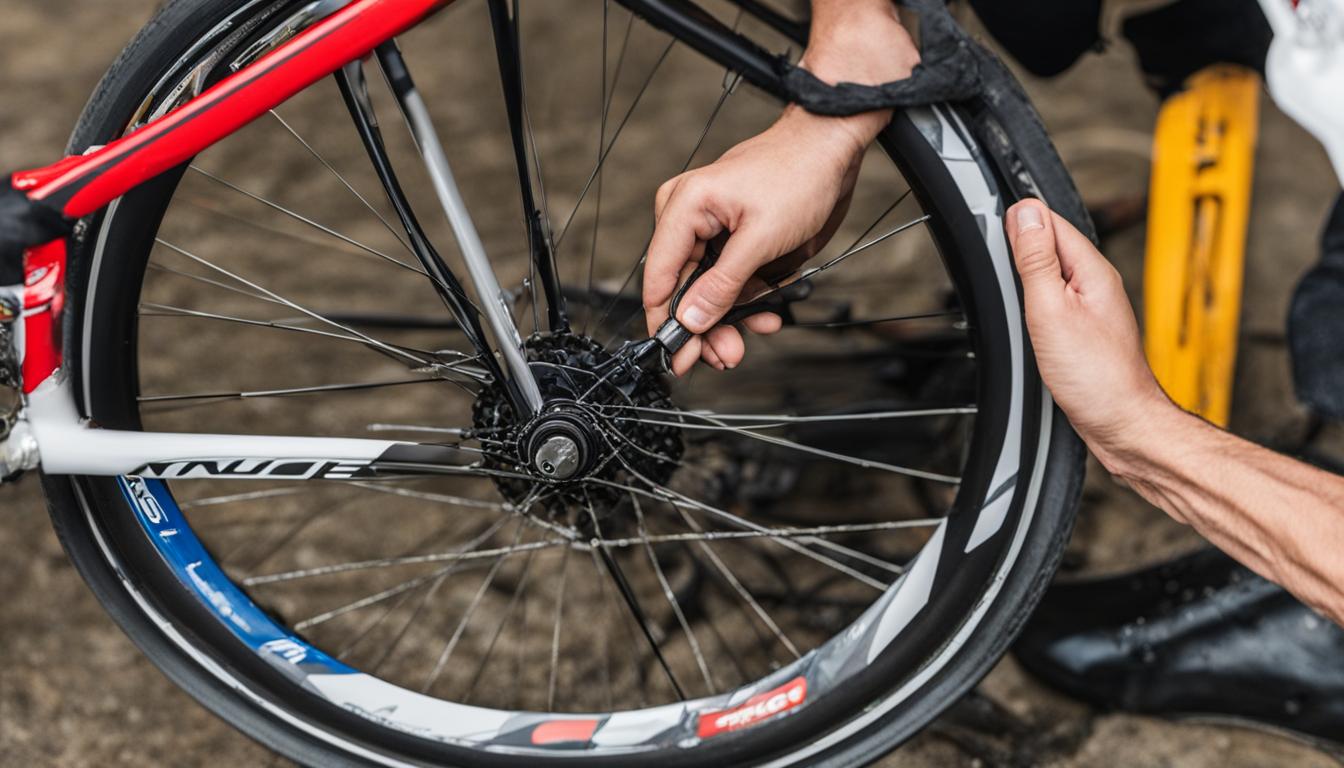
Valve Replacement for Tubeless Tires
Replacing a valve on a tubeless tire may be necessary if the seal fails or the valve becomes damaged. To replace a tubeless valve:
- Deflate the tire completely.
- Using a valve core remover or a pair of pliers, remove the valve core from the existing valve.
- Unscrew the knurled nut and remove the old valve.
- Insert the new valve through the valve hole in the rim, ensuring it is seated correctly.
- Screw on the knurled nut until it is snug to create an airtight seal.
- Reinflate the tire and check for any leaks.
By following these steps, you can easily replace a tubeless valve and get back on the road quickly and safely.
Links to Tubes and Supplies
When it comes to choosing the right tubes for your bicycle tires, it’s important to consider the type of valve your bike uses. Different valve types require specific tubes for a proper fit. Let’s take a closer look at the various options available:
Schrader Tubes
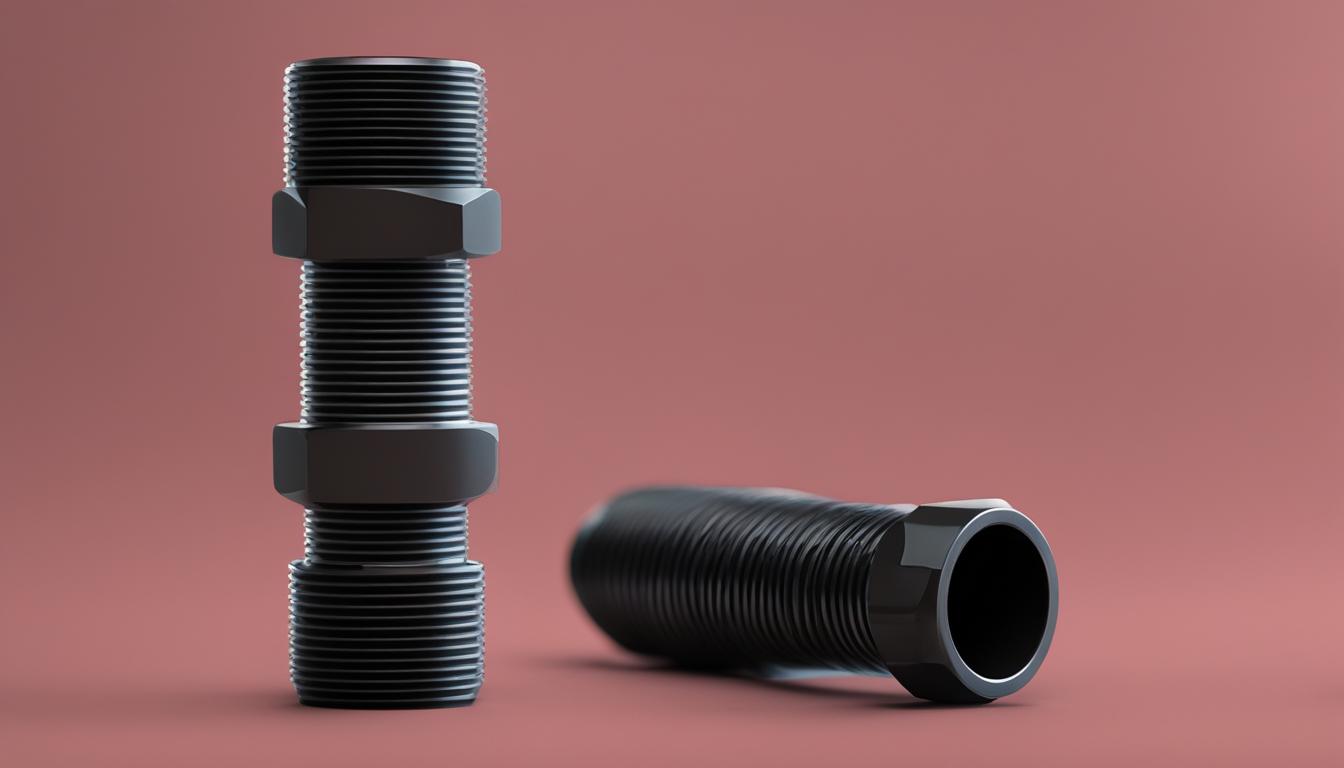
Schrader valves are commonly found on a wide range of bikes, including mountain bikes, hybrid bikes, and many kids’ bikes. If your bike has a Schrader valve, you’ll need Schrader tubes to ensure a proper fit. These tubes are readily available and can be found at most bike shops or online retailers. It’s always a good idea to keep a few spare tubes on hand in case of punctures or emergencies.
Presta Tubes
Presta valves are typically used on road bikes, high-performance bikes, and some mountain bikes. These valves require specific Presta tubes for a secure fit. Presta tubes are lightweight and designed for higher pressures, making them an ideal choice for road cyclists and avid riders. Just like with Schrader tubes, it’s always wise to have spare Presta tubes in case of flats.
Dunlop Valve Tubes
Dunlop valves, also known as Woods valves, are less common but can be found on city bikes and some European or Asian models. If your bike utilizes a Dunlop valve, you’ll need Dunlop valve tubes to ensure compatibility. While these tubes may be a bit harder to find, they are still available through various bike shops and online retailers.
Remember, choosing the correct size valve for your rim is crucial for a proper fit. Additionally, having spare tubes on hand can save you from unexpected surprises during your rides. Regardless of the valve type, proper maintenance and regular inspections of your tires will help ensure smooth and enjoyable cycling experiences.
Different Types of Bike Tire Valves
In addition to the traditional Schrader, Presta, and Dunlop valves, there are also new valve types emerging, especially for tubeless tire technology. These new valve types are designed for rapid airflow and improved performance on specific rims. They are often used on high-end bikes with carbon rims.
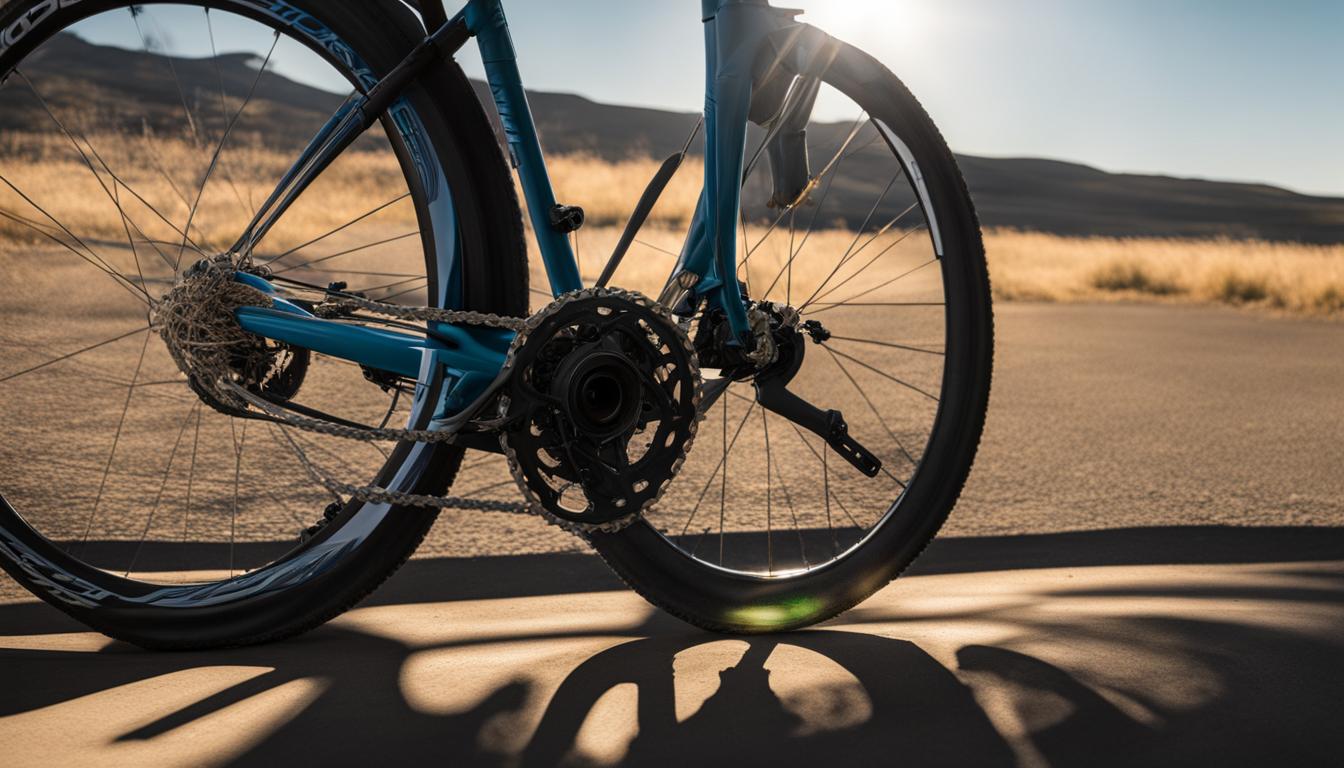
Tubeless valves have become increasingly popular among cyclists seeking enhanced performance and reliability. These valves are specifically designed for use with tubeless tires, which eliminate the need for an inner tube by creating an airtight seal between the tire and rim. Tubeless valves feature a removable core that allows for easy tire installation and maintenance.
One of the key advantages of tubeless valves is the ability to run lower tire pressures without the risk of pinch flats. This can provide a smoother and more comfortable ride, especially when tackling rough terrain or off-road trails.
Furthermore, tubeless valves often incorporate features such as valve stems made of lightweight materials like aluminum or titanium, reducing rotational weight and improving overall performance. These valves also have a larger diameter for increased airflow, allowing for quicker inflation and deflation of the tire.
It is important to note that while tubeless valves may offer significant benefits, they require a tubeless-ready rim and tire setup. This means that both the rim and tire need to be designed specifically for tubeless use, with an airtight seal and compatible bead construction.
Overall, the emergence of different valve types, including tubeless valves, provides cyclists with a wider range of options to meet their specific riding needs. Whether it’s the reliability of traditional valves or the cutting-edge performance of tubeless technology, choosing the right valve can greatly enhance your biking experience.
Choosing the Right Valve for Your Needs
When it comes to choosing a valve for your bike tire, it’s important to consider your specific needs and preferences. Different valve types have their own pros and cons, and understanding them can help you make an informed decision. Let’s take a look at the three main valve types: Schrader, Presta, and Dunlop.
The Schrader Valve
The Schrader valve, also known as the car valve, is the most common type of valve found on bicycles. These valves are wider and easier to inflate, making them a popular choice for casual riders and mountain bikers. They are also more resilient and can withstand rough handling.
The Presta Valve
The Presta valve, often found on road bikes and high-performance bicycles, is narrower and designed with a threaded stem. This design allows for higher air pressures and a more secure seal. Presta valves are lighter and better suited for riders who prioritize weight savings and require higher performance capabilities.
The Dunlop Valve
The Dunlop valve, also known as the Woods valve, is commonly used in Europe and Asia. These valves are wider and often found on city bikes. While not as popular as Schrader and Presta valves, they are still a viable option for certain riding styles and preferences.
When choosing a valve, consider the type of rims you have and whether you plan on using tubeless tires. Additionally, think about your riding style and the type of bike you own. Each valve type has its advantages and disadvantages, so weigh them carefully to make the best decision for your needs.
Now that we have discussed the different types of valves, let’s take a closer look at their pros and cons.
| Valve Type | Pros | Cons |
|---|---|---|
| Schrader Valve | Easy to inflate Durable and resilient Compatible with most pumps |
Heavier than Presta valves A larger hole in the rim may weaken the structure |
| Presta Valve | Lightweight Allows for higher air pressures Better suited for high-performance bikes |
Requires an adapter for some pumps The thinner stem may be more prone to damage |
| Dunlop Valve | Wider valve for rapid airflow Used on city bikes |
Less common and may be harder to find replacement tubes May not be suitable for all rims |
Now that you have a good understanding of the different valve types and their pros and cons, you can confidently choose the right valve for your bike tire. Consider your specific needs, the type of rims you have, and the type of riding you will be doing. Making an informed decision will ensure that you have the best value for your biking adventures.
Pump Selection for Different Valves
When it comes to maintaining your bike tires, selecting the right pump is crucial. You need to ensure that the pump you choose is compatible with the valve type on your bike. Let’s take a closer look at the different options and considerations.
Some pumps come with dual-head designs that can accommodate both Schrader and Presta valves. These versatile pumps offer convenience and flexibility, allowing you to use the same pump for different types of tires. However, not all pumps have this feature, so it’s important to check the specifications before making a purchase.
If your pump doesn’t have a dual-head design, don’t worry. You can still use a Schrader-specific pump for Schrader valves or a Presta-specific pump for Presta valves. These pumps are specifically designed to fit their respective valve types, ensuring a proper seal and efficient inflation.
Alternatively, if you have a Schrader pump but own a bike with Presta valves, you can use an adapter. Adapters are small, inexpensive accessories that allow you to use a Schrader pump with Presta valves. They make the connection between the pump and valve seamless, providing a secure fit for inflation.
On the other hand, if you prefer the convenience of CO2 inflators, it’s essential to note that they are often only compatible with Presta valves. CO2 inflators offer quick and efficient tire inflation, making them popular among cyclists. However, if your bike has Schrader or Dunlop valves, you’ll need to explore alternative inflation methods.
Now that you know the importance of choosing the right pump for your bike tire valve, let’s summarize the key points:
- Ensure the pump you select is compatible with the valve type on your bike
- Consider a pump with a dual-head design for versatility
- Use a Schrader-specific pump for Schrader valves and a Presta-specific pump for Presta valves
- Use an adapter to convert a Schrader pump for use with Presta valves
- Check the compatibility of CO2 inflators with your valve type
“Choosing the right pump is essential for proper tire maintenance and inflation.”
By selecting the right pump for your bike tire valve, you can ensure a seamless and efficient inflation process. Whether you opt for a dual-head pump, valve-specific pump, or adapters, make sure that the pump you choose is compatible with your valve type for optimal performance.
| Pump Type | Compatibility |
|---|---|
| Dual-head design | Accommodates both Schrader and Presta valves |
| Schrader-specific pump | Compatible with Schrader valves |
| Presta-specific pump | Compatible with Presta valves |
| Adapter | Allows the use of a Schrader pump with Presta valves |
| CO2 inflator | Often compatible with Presta valves |
Conclusion
Understanding the different types of bike tire valves is crucial for maintaining and repairing your bicycle. Whether you have a Schrader, Presta, or Dunlop valve, choosing the right equipment ensures a smooth and hassle-free cycling experience.
Each valve type has its own advantages and disadvantages. Schrader valves, commonly found on inexpensive bikes, are wider and have a spring-loaded check valve for easy airflow control. Presta valves, used on higher-end bikes, are narrower and create an airtight seal with a threaded stem. Dunlop valves, popular in Europe and Asia, are wider and often used on city bikes.
When selecting a valve type, consider the specific needs of your bike and the type of rims you have. If you own a road or high-performance bike, Presta valves offer lighter weight and higher air pressure capacity. On the other hand, Schrader valves are more common and easier to find.
By understanding the pros and cons of each valve type, you can make an informed decision and choose the valve that best suits your needs. Whether you’re a casual cyclist or a competitive rider, the right valve type will ensure optimal performance and longevity for your bike tires.
FAQ
What are the different types of bike tire valves?
The different types of bike tire valves are Schrader, Presta, and Dunlop valves.
Why do bikes use Presta valves?
Bikes use Presta valves because they are lighter, better suited for high-performance bikes, and create a stronger rim by requiring a smaller hole.
Can you mismatch Presta and Schrader valves?
It is possible to use a Presta-specific tube on a rim drilled for Schrader valves, but it is not advised for anything more than an emergency fix. Widening a valve hole or using a Schrader tube on a Presta-drilled rim is not recommended.
What are the appropriate valve lengths for bicycle tires?
The appropriate valve length for bicycle tires depends on the depth of the rims. Most Presta tubes have valves 40 to 48mm long, but deep-section aero wheels may require longer valves up to 80mm or 100mm.
Which pump should I use with these valves?
There are pumps designed specifically for Schrader valves, Presta valves, and Dunlop valves. Some pumps have dual-head designs that can accommodate both Schrader and Presta valves. Adaptors can also be purchased to use a Schrader pump with Presta valves.
Will I need to replace a valve?
Most valves are already attached to tubes, so replacing one means replacing the whole tube. However, in the case of tubeless tires, Presta valves with a knurled nut and seal can be replaced if the seal fails. Some Presta valves also have replaceable cores.
Where can I find tubes and supplies for different valve types?
Schrader tubes, Presta tubes, and Dunlop valve tubes can be found at bike shops, online retailers, or in sporting goods stores.
What are the different types of bike tire valves?
The different types of bike tire valves include Schrader valves, Presta valves, Dunlop valves, and tubeless valves. Schrader valves are commonly found on inexpensive bikes, Presta valves are used on high-performance bikes, and Dunlop valves are often used on city bikes.
How do I choose the right valve for my bike?
When choosing a valve for your bike, consider the type of rims you have, the type of bike you ride, and whether you plan on using tubeless tires. Each valve type has its own advantages and disadvantages.
How do I select a pump for my bike tire valve?
When selecting a pump, ensure it is compatible with the valve type on your bike. Some pumps have dual-head designs that can accommodate both Schrader and Presta valves, while others may require adapters.
What are the different types of bike tire valves?
The different types of bike tire valves include Schrader valves, Presta valves, and Dunlop valves. Tubeless valves are also used for tubeless tire technology.

